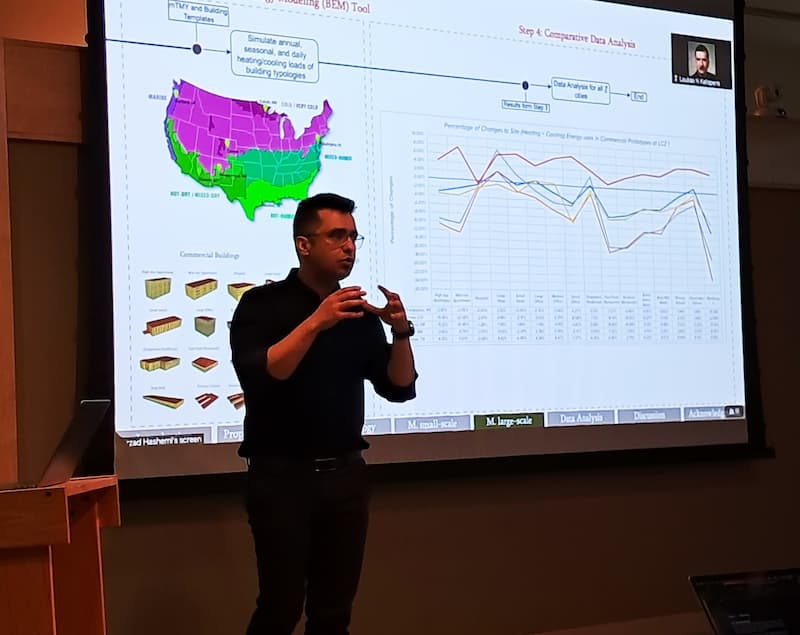Posted on April 2, 2024 by Sean M. Wood

Farzad Hashemi presenting his dissertation research
Accurate climate data is crucial in shaping energy-efficient building designs in sustainable urban development. Dr. Farzad Hashemi, Assistant Professor of Architecture at the Margie and Bill Klesse College of Engineering and Integrated Design, has been recognized for his groundbreaking research on this topic.

Hashemi was recently presented with the dissertation award by the Architectural Research Centers Consortium (ARCC) for his doctoral research, which introduces a novel methodology for simulating climate data tailored to urban environments. The ARCC Dissertation Award recognizes excellence in dissertation research by a doctoral student from an ARCC member school. The award honors significant new research in architecture and environmental design and to recognize the achievement of an emerging scholar.
Hashemi's dissertation journey began with a deep interest in exploring the interplay between buildings and their surrounding environment. This curiosity originated during his master's studies at Iowa State University, and he pursued it further in his Ph.D. studies at Penn State. Identifying a significant limitation in conventional climate data, such as Typical Meteorological Year (TMY) data, which often fails to accurately reflect urban climates, Hashemi embarked on a mission to address this issue through a novel methodology.
Hashemi's methodology couples local climate zones (LCZs) with the Urban Weather Generator (UWG) tool, accurately representing urban climates and capturing cities’ unique thermal dynamics. By surpassing the limitations of observable weather data gathered from open spaces like airports, Hashemi's research offers a detailed evaluation of how the urban heat island (UHI) affects energy consumption in buildings.
Hashemi selected seven U.S. cities for his Ph.D. research, each in a distinct climate zone. They ranged from Phoenix's hot and dry conditions to the frigid environment of Duluth, Minnesota. This diverse selection was crucial to ensure the versatility and applicability of his research methods and the generated climate data across a broad spectrum of urban environments and weather scenarios.
"My primary goal was to provide architects and urban planners with a reliable workflow to assess the energy demands of urban buildings, while comprehensively considering the impact of the built environment, especially the UHI effect," Hashemi says.
His work addresses the limitations of conventional weather data collection methods. It also prioritizes accessibility, ensuring a broad audience can use his tools and methodologies. By basing his developments on free or widely accessible software, Hashemi enables professionals, researchers, and students to apply this methodology efficiently in their projects.
"Achieving energy efficiency in buildings is pivotal for reducing energy consumption and curbing greenhouse gas emissions, but it also plays a crucial role in cooling our urban environments," he says. "My research delves into this interplay, demonstrating how tailored climate data for urban settings can inform smarter, energy-efficient building designs."
Hashemi's innovative approach highlights the importance of interdisciplinary efforts in creating sustainable, cooler cities better equipped to face the UHI challenges. As UTSA continues to drive research excellence in sustainable urban development, Hashemi's work is a testament to the university's commitment to advancing knowledge and addressing real-world challenges.

